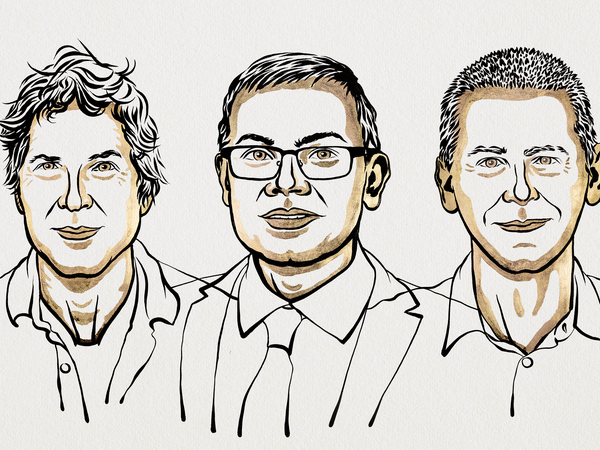This year's Nobel Prize in Chemistry was awarded to David Baker, an American biochemist at the University of Washington in Seattle (USA), and to Demis Hassabis and John Jumper, computer scientists at Google DeepMind, an artificial intelligence research laboratory based in London (UK). The prize was awarded half to David Baker for ‘computational protein design’ and the other half jointly to Demis Hassabis and John M. Jumper for ‘protein structure prediction’.
Proteins are small molecular machines that control and drive all biological processes occurring in a living organism. These include the catalysis of metabolic reactions, DNA replication, immune defence and signalling between different cells and organs. Proteins are biopolymers composed of twenty different amino acids, which can be described as the building blocks of life. The order in which these different building blocks are distributed within the protein polymer uniquely determines its shape, also known as three-dimensional structure, which is intrinsically linked to the biological function. Knowing it in detail is crucial to fully understand its function and, if necessary, design drugs that modulate its activity. For example, determining the three-dimensional structure of the proteins of the SARS-CoV-2 virus has enabled scientists to understand how the virus works, develop initial treatments and further conceive new mRNA vaccines.
However, the experimental determination of the three-dimensional structure of a protein is a very expensive and time-consuming process. By applying X-ray crystallography or cryo-electron microscopy, scientists have managed to determine the structure of around 300,000 different proteins over the past 60 years. However, this number represents only a very small fraction (~0.1%) of all the different naturally occurring protein sequences that have been catalogued so far (~300 million). Experimental determination of the three-dimensional structure of all these proteins could take decades.
The development of the AlphaFold system, which uses an artificial intelligence algorithm developed by Demis Hassabis and John M. Jumper, has overturned expectations by enabling the accurate prediction of the three-dimensional structure of any protein in a very short timeframe and at a low cost. AlphaFold database, first launched in the summer of 2021 with just over 360,000 protein structure predictions, including all known human proteins, has grown exponentially to almost 200 million protein structures from over 1 million different organisms. Notably, AlphaFold is an open-access database, a key factor that has contributed to its remarkable success. The AlphaFold database is therefore a true example of ‘open science’, used so far by more than two million researchers from more than 150 different countries.
While Demis Hassabis and John M. Jumper realised a fifty-year-old dream with AlphaFold: predicting protein structures from their amino acid sequences, David Baker and his collaborators have gone one step further. Since 2003, David Baker's research group has contributed significantly to the development of innovative computational methods capable of designing unique proteins that have not yet been discovered or may never have existed in nature. The protein models designed by David Baker and his collaborators have proven to be extremely reliable and have enabled the generation of innovative drugs, vaccines, nanomaterials and biosensors that are currently being developed industrially.
To best describe the impact these discoveries will have in the future years, I quote the Nobel Foundation's press release: “Life could not exist without proteins. That we can now predict protein structures and design our own proteins confers the greatest benefit to humankind.”
Our university has not remained indifferent to these challenges; indeed, in recent years, it has been active both at the teaching and research levels. Basic knowledge regarding the prediction and computational design of proteins is provided to students of the Master's degree programme in Bio and Nanomaterials Science and Technology (CM14) and to those of Biomolecular Chemistry, a curriculum of the Master's degree programme in Chemistry and Sustainable Technologies (CM7). Research-wise, these topics are covered in depth in the interdisciplinary project ALLIANCE (“A novel integrated cyclic peptide-based platform for precision delivery of nucleic acid-based therapeutics”), funded by the National Recovery and Resilience Plan (PNRR) of the European Union (Next Generation-EU) and part of the National Center for Gene Therapy and Drugs based on RNA Technology. This ambitious research project involves the use of innovative computational methodologies to design miniaturised proteins, called cyclic peptides, capable of precisely delivering nucleic acid-based therapeutic molecules to selected tissue for the treatment of cancer and genetic diseases. The project involves numerous professors and researchers from the Department of Molecular Sciences and Nanosystems (DMSN) and the Department of Environmental Sciences, Informatics and Statistics (DAIS). Prof. Achille Giacometti, Prof. Marco Nobile, Prof. Flavio Romano, Dr. Marta Simeoni, Dr. Tatjana Skrbic, Dr. Silvia Multari and Dr. Cristian Fregonese are involved in the computational design of the miniaturised proteins, while Prof. Alessandro Angelini, Prof. Alessandro Scarso, Prof. Fabrizio Fabris, Prof. Federico Polo, Prof. Giulia Fiorani, Dr. Sara Linciano, Dr. Zhanna Romanyuk and Dr. Matilde Salvadoretti are involved in the characterisation and experimental validation of the computationally predicted three-dimensional structures. If successful, these computationally designed drugs will not only impact patient health, but could also have significant scientific, technological, and economic implications.










